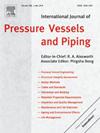A TSC model for pipelines girth weld considering variations in toughness across different regions
IF 3
2区 工程技术
Q2 ENGINEERING, MECHANICAL
International Journal of Pressure Vessels and Piping
Pub Date : 2025-02-20
DOI:10.1016/j.ijpvp.2025.105470
引用次数: 0
Abstract
The tensile strain capacity (TSC) model serves as a robust tool for assessing the integrity of pipeline girth welds and associated defects. However, existing TSC models predominantly rely on static crack methods, making it challenging to capture the effects of crack propagation and fracture toughness on the load-bearing capacity of pipeline girth welds. Therefore, this study investigated the initiation and propagation of pipeline cracks using the Gurson-Tvergaard-Needleman (GTN) model. A novel method was introduced for the first time to characterize toughness variations across different regions of pipeline girth welds, employing Charpy impact energy. The study examined how differences in strength matching and toughness affect crack initiation location, and proposed a criterion for evaluating remote strain at the point of crack wall penetration. Based on this, the influence of crack location and size on the load-bearing capacity of pipeline girth welds was analyzed. Additionally, the effects of strength matching, the degree of softening in the heat-affected zone (HAZ), and toughness differences on load-bearing capacity were investigated. The study also proposed a novel predictive formula for tensile strain capacity, incorporating these factors. Results indicate that toughness significantly influences crack initiation location more than strength matching or HAZ softening, with cracks tending to initiate at regions of lower toughness even if strength is higher. Pipeline load-bearing capacity was found to be lower when crack initiation occurred within the HAZ. Moreover, load-bearing capacity increased with the strength matching coefficient, HAZ matching coefficient, and toughness matching coefficient, with this relationship fitting a quadratic function. Conversely, the load-bearing capacity of pipeline girth welds is inversely proportional to crack depth and length. The newly developed predictive formula demonstrated a normal distribution error margin within 10 %, confirming its accuracy. These findings are valuable for addressing TSC conservatism and expanding its applicability.
考虑不同区域韧性变化的管道环焊缝TSC模型
拉伸应变能力(TSC)模型是评估管道环焊缝完整性和相关缺陷的可靠工具。然而,现有的TSC模型主要依赖于静态裂纹方法,难以捕捉裂纹扩展和断裂韧性对管道环焊缝承载能力的影响。因此,本研究采用Gurson-Tvergaard-Needleman (GTN)模型研究管道裂纹的起裂和扩展。首次提出了一种利用夏比冲击能表征管道环焊缝不同区域韧性变化的新方法。研究了强度匹配和韧性的差异对裂纹起裂位置的影响,并提出了一种评价裂纹穿透点远端应变的准则。在此基础上,分析了裂纹位置和裂纹尺寸对管道环焊缝承载能力的影响。此外,还研究了强度匹配、热影响区软化程度和韧性差异对承载能力的影响。该研究还提出了一个新的拉应变能力预测公式,结合这些因素。结果表明,与强度匹配或热影响区软化相比,韧性对裂纹萌生位置的影响更大,即使强度较高,裂纹也倾向于在韧性较低的区域萌生。在热影响区内发生裂纹时,管道承载能力较低。承载能力随强度匹配系数、热影响区匹配系数和韧性匹配系数的增大而增大,三者之间的关系拟合为二次函数。反之,管道环焊缝的承载能力与裂纹深度和长度成反比。新开发的预测公式误差在10%以内为正态分布,证实了其准确性。这些发现对于解决TSC保守性问题和扩大其适用性具有重要意义。
本文章由计算机程序翻译,如有差异,请以英文原文为准。
求助全文
约1分钟内获得全文
求助全文
来源期刊
CiteScore
5.30
自引率
13.30%
发文量
208
审稿时长
17 months
期刊介绍:
Pressure vessel engineering technology is of importance in many branches of industry. This journal publishes the latest research results and related information on all its associated aspects, with particular emphasis on the structural integrity assessment, maintenance and life extension of pressurised process engineering plants.
The anticipated coverage of the International Journal of Pressure Vessels and Piping ranges from simple mass-produced pressure vessels to large custom-built vessels and tanks. Pressure vessels technology is a developing field, and contributions on the following topics will therefore be welcome:
• Pressure vessel engineering
• Structural integrity assessment
• Design methods
• Codes and standards
• Fabrication and welding
• Materials properties requirements
• Inspection and quality management
• Maintenance and life extension
• Ageing and environmental effects
• Life management
Of particular importance are papers covering aspects of significant practical application which could lead to major improvements in economy, reliability and useful life. While most accepted papers represent the results of original applied research, critical reviews of topical interest by world-leading experts will also appear from time to time.
International Journal of Pressure Vessels and Piping is indispensable reading for engineering professionals involved in the energy, petrochemicals, process plant, transport, aerospace and related industries; for manufacturers of pressure vessels and ancillary equipment; and for academics pursuing research in these areas.

 求助内容:
求助内容: 应助结果提醒方式:
应助结果提醒方式:


